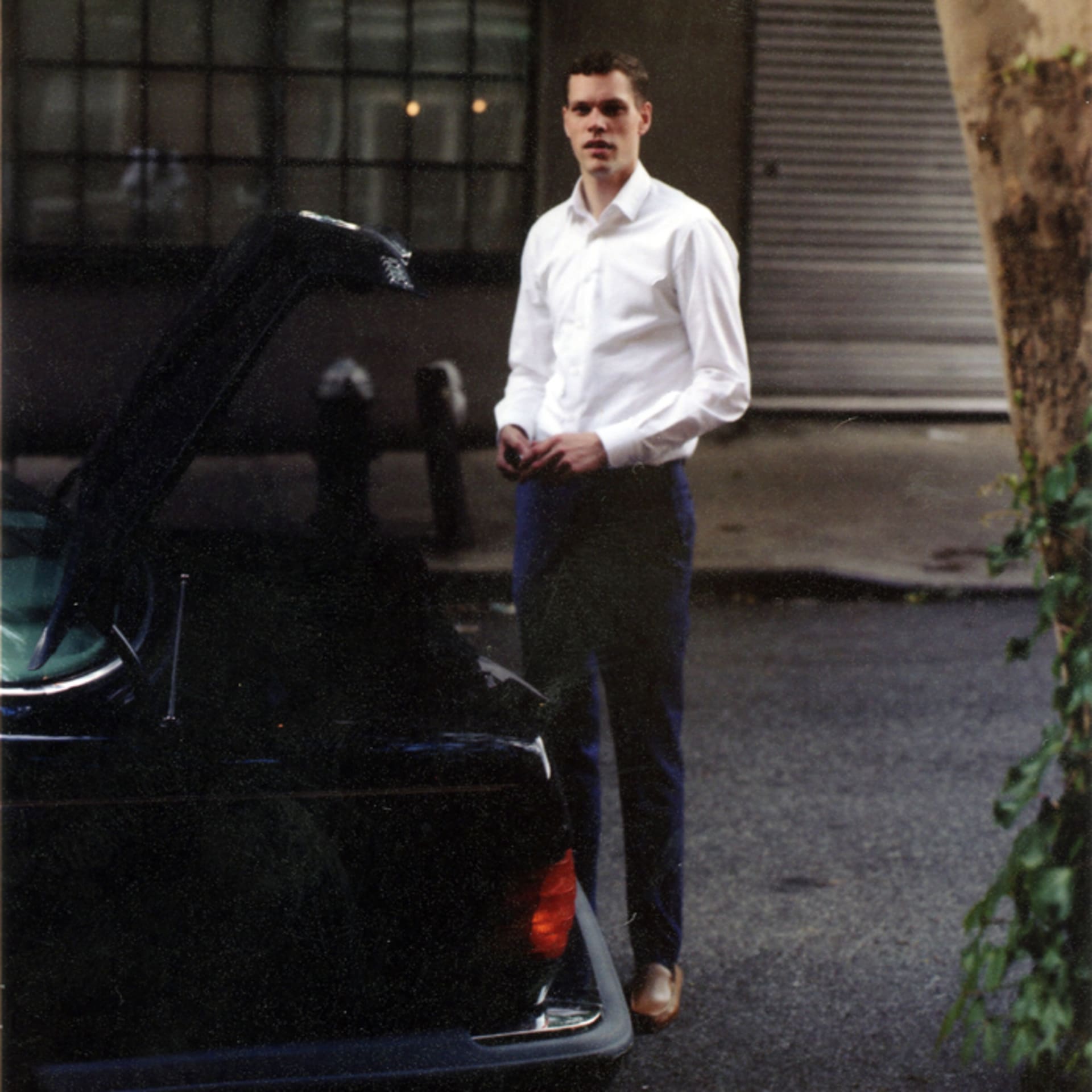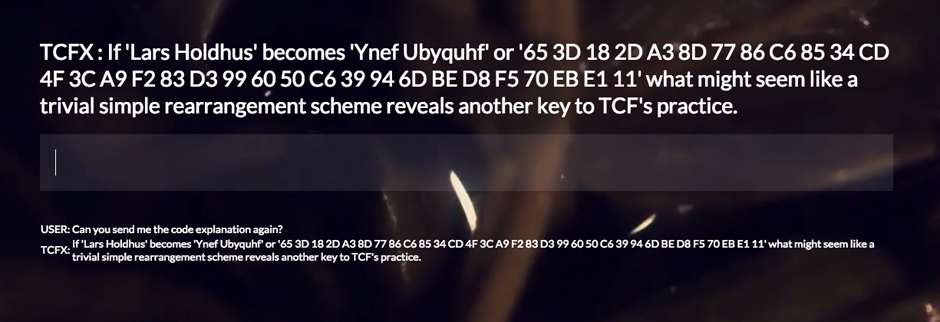
Getting Deep With Janus Affiliate TCF At CTM Festival
Lars Holdhus is nothing if not meticulous. I met the Berlin-based artist after a live performance and lecture on artificial intelligence at the CTM Festival, and found him to be a fastidious musician and visual artist as well as an obsessive tea and cider connoisseur. For Holdhus, all pursuits are artistic, and the vacuum pack of Oolong Tea I depart with is hand-stamped with the same “TCF” moniker he assigns to his music.
Since his first tape release in 2013 on the Berlin imprint YYAA, the Norwegian multimedia artist has pricked discerning ears with detailed electronic productions that transform code into musical sounds and structures. The code-based titles he assigns to tracks, such as “D7 08 2A 8D 2A 37 FA FE 17 0E 62 39 06 81 C8 A1 49 30 6F ED 56 AD 5E 04,” belie the seductive, playful quality of his music, which dramatically blends hardstyle riffs, glitchy ambience, and grimey brass. His latest project, TCFX, is a command line that allows users to input text and chat with an algorithm that responds to their submissions with text and code.

Holdhus’ other endeavors include regular appearances at Berlin’s Janus party, and fellow resident M.E.S.H penned a gushing recommendation for the most recent TCF release on Liberation Technologies in the latest issue of Electronic Beats Magazine. During our conversation, however, he seemed admirably hermetic, and consumed by an interactive, socially pertinent practice which constitutes his primary engagement with the world.
Laurie Tompkins: Could you give me a picture in layman’s terms of how you use code to make your work?
Lars Holdus AKA TCF: Well, I try to use code in every possible way. There are basic approaches—like turning images or simple code into sound—or more advanced techniques where you go into the micro level of sound and insert things. If you imagine sound as an object, you can approach it from all angles and inject things into it. I’m obsessed with building systems for my own sake more than actually communicating them. There’s a certain feedback in my practice, and it’s mainly feedback back to me and not to every single listener. I’m not necessarily interested in seeing something that you immediately understand and that’s it. Maybe in the future we will all produce our own things, instead of the producer making something for the listener.
Do you find that listeners hold onto that sense of expectation more than visual art audiences?
They’re very different, and I like that. I appreciate all the different entry points that people can take. I’m a visual artist, but I also import tea into Germany for example. People can enter through these different avenues and then take their own stand towards my practice. I’m just building systems all the time, and people can follow and see what’s there. I take into account everything that people say and sometimes I incorporate it into the next performance. I like the idea that you’re a part of this larger group of people, and that the listener is also a part of the creation itself.
As much as the listener navigates dense layers of sound, the way that the your live set progresses from moment to moment is really unusual. It’s as if your visual or conceptual perspective on sound pushes you into new musical patterns.
I think it comes from everything you mention. There’s some structure to my live set-up but it can also flow in all directions. I want to perform highly complex pieces of music that utilize the complexity of the computer but also me as the performer. There’s a game between us and I try to feel that tension. You have to incorporate humour in subtle ways, so that some will pick it up and enjoy it, but in such a way that the humour won’t break the vision of the rest. I keep the experience open. I don’t want to direct people’s feelings in certain directions—I don’t even know myself how it will develop.
How does the reaction to your show change from the club to a concert space? Do people ever move to the music?
So far, it’s been a listening experience. I like people to be seated, and if people feel like sleeping, I’m not offended. Why not? I play to keep my own brain active, and it’s almost like an exercise, simply a continuation of producing. Some people might be disappointed because there’s no highlights or dramatic structure to the performance, but I’m not so passionate about those expectations.
I tend to associate the idea of people sleeping in concerts with ambient music. Your releases certainly have similarities with that style of music, but there’s also dramatic, detailed gestures, like massive rave synths. How do you make the two work together? Is it active on the small scale and more placid as a whole?
You have to be a very active listener, as you can’t just put it on in the background. That’s how a lot of people use ambient music, because it doesn’t demand your attention in the same way. People would find it annoying if my stuff was on in the background. Some people also say that about the live performance, that they’d like it to be simpler, with a clearer narrative, but that critique doesn’t really fit with my intentions. My intention is to make the audio more complex than I can perform, and sometimes it becomes clear to me that I can’t perform it, which is an interesting process.
What’s interesting about using the brash rave sounds is that they’re tied in with an implied narrative in that they’re associated with build-ups to a massive drop. You’ve got an interesting pull there.
I try to move these sounds outside of a club environment and see them as another instrument. I enjoy that culture a lot, but my latest record doesn’t really have anything to do with it. It’s important to separate the instruments from the music, and to remember that these hardstyle elements can function in so many other ways. You can take these elements and use them without that connotation.
There’s actually a lot of traditional compositional craft in your work. The details add up to much more than pure concept.
I come from a purely conceptual background; as a visual artists I am trained in concepts. But it’s interesting to navigate between that and more classical compositional values. I see myself primarily as a composer. Although I’m not classically trained, I somehow manage to navigate in that world and I continue to try to learn from previous composers. As a visual artist, I have an interest in studying composers in a way that I can understand it. I don’t do classical notation but I’m a computer composer, so I essentially study MIDI.
So you assess notation purely visually?
Yeah, and just read up on it. All of the electroacoustic pioneers are also very important, and all these things come together if you really study it. It all merges into TCF.
Is our ability to collide these disparate influences a condition of a society that’s mediated by the Internet? Are noise, personal codes, and retro dance styles all just cultural detritus available for us to use?
The internet is so integrated into our lives that there’s no separation anymore between life and the Internet. I just see it as a platform that society uses in various ways. It’s a part of the work, but I don’t want to make a distinction between one or the other because it all comes back to human action.
You’re presenting people with something that contains all of life’s messiness, and data is a very contemporary manifestation of that idea.
This is something that affects the contemporary being, and we can’t not relate to it. I mean, I don’t think that there’s one way to express something, and that’s because I never really believed that you could express something; you can’t take something and make it happen in another medium, you can only make a translation. So I find it strange when people say to me that “This really relates to today,” because everything around us relates to today. So I can’t say that I’m trying to “coin” today, I’m just experiencing this world and trying to describe it. Others do the same, and arguably anyone who makes anything makes an accurate representation of today, even with all its flaws or nostalgia. It has to exist in our society for us to utilize it.
Clearly code allows you to escape musical habits, but there’s another side to code which is the fear that life is being reduced simply to data, and stored.
I don’t think that life can be reduced to data—it can only be transformed into data. If you say you can reduce life to data, you would also have to say that life has a certain size or value. Imagine in the future when we can measure more aspects of human life than we can conceive, then it’s certainly not reduced. It’s the way that humans read data that is reduced. In terms of politics, the way that data is used is often very problematic, we need to regulate the ways it’s used. You could argue that quantifying life in any way is problematic, but it has been happening since technology emerged, since punch cards and even before that. Humans have this impulse to quantify and organize life, and maybe we should be talking about how you organize it rather than simply advocating chaos. How much true anarchy do you want, and what level of self-regulation?
If we read your work in this sense, you’re not trying to project a world view or manifesto, you’re simply using these materials to prompt these questions?
It’s good to be informed and value all aspects of this discussion and then people can take their own stand on it. I’m not going to tell people what to think and have a heaven and hell perspective on things. This world’s not like that, and it never has been like that either. I don’t like to inform people directly but ask them to consider that there is a certain complexity to life and we must all find our own way to navigate in it.
Click here to read Laurie Tompkins’ guide to the most compelling installations at CTM and Transmediale.
Published February 20, 2015. Words by laurietompkins.
